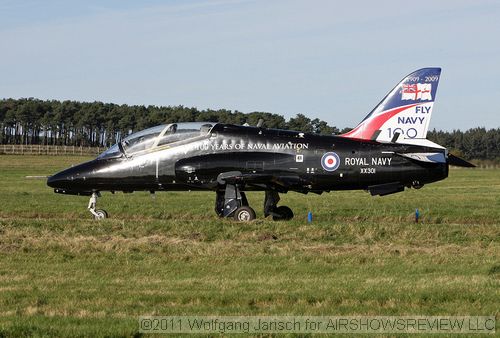2011
Air Force Exercise
|
Joint
Warrior 2/2011, Scotland |
Location: Scotland |
Admission:
Not open to the public |
Parking: NA |
| Value: Very
Good |
|
For the second time this year, AirShowsReview is back in Lossiemouth,
Scotland, for the second part of the Joint Warrior 11 Exercises.
The first part is reviwed here:
http://airshowsreview.com/Joint_Warrior_1-2011.htm Our team consisted of our main European
correspondents: Peter from Germany and Wolfgang from Austria. Just
the beautiful scenery around Lossie, alone is worth the long drive. |
AirShowsReview covered the first part
JW exercise in our June 2011 issue. The second JW exercise for this
year was held from 3rd to 13th October. The JW encompasses a programme
of exercises conducted by land forces, naval forces and aircraft
across the UK with the maritime element focused in the offshore and
coastal waters to the north east, north and north west of Scotland.
Joint Warrior providing a joint training in a multi-threat environment
for the UK, NATO and allied Forces to enable them to operate together,
a very important considering the tensions in northern Africa and
the Middle East. |
Our
team arrived on Monday the 10th, for the second week. Kinloss AFB
was already closed, and most of the aircraft are concentrated in
Lossiemouth. In addition several Eurofighters from the Royal Air
Force and three German Tornados were also involved in the exercise,
but they operated from Leuchars AFB. Our arrival was treated by
20 minutes of rain, with rain forecasted for the rest of the week,
but this turned out to be for the most of the time false. As during
our stay we had many hours of beautiful sunshine which allowed
us to take high quality images in large quantity. In fact enough
that by end of Wednesday, we didn’t had to spend
the cloudy day on Thursday at the base and decided to explore the
nearby distilleries in the highlands, but that is another story. |
On
Monday morning, we saw a line of six US-Navy P3-C Orions and a
CP-140 Aurora from the Canadian Forces ( 407 sqn. “Demon” from CFB
Comax) and the ramp was full with Tornados from
the 15 th squadron. Opposite to the ramp, the former ramp of the
disbanded 14 th squadron parked a French Navy Atlantic ATL2 (Nr.
4 from 21./23. Flotille Lorient/Lann-Bihoué) , seven Dassault
Falcon 20 belonging to FRADU ( Fleet Requirements and Air Direction
Unit), based in Bournemouth, and eight Hawks T1A from Culdrose
and Leeming (100 Sqn.). |
| The
P3-C Orions were from NAS Jacksonville in Florida. Five P3-C aircraft
from the VP-16 “War Eagles”,eight
combat aircrews and 70 percent of the squadron´s maintenance
department had packed their bags and headed to northern Scotland.
The War Eagles were joined by aircraft from their sister squadron,
the VP-45 “Pelicans”. The VP-16 CAC´s flew more
than 40 sorties, as well as executing over 240 flight hours. The
War Eagles flew sorties conducting anti-submarine, anti-surface
and surveillance missions for the exercise. The US-Navy had one
Orion permanently in the sky. The Orion sorties took about 6 hours.
Therefore we had the chance to see all the Orions taking off or
landing by daylight during the week. All the days were very eventful
with flight operations. Tornados, Falcons and the Hawks were going
and coming. It was interesting to see the variety of the different
weapons and target pods on the Tornados. We saw two Tornados with
the TIALD Pod ( Thermal
Imaging Airborne Laser Designer Pod), while the rest of the Tornados
flew with pods, had the LDP Rafael Lightning pod. One of the Hawks
was armed with the Aden cannon on the centre pylon and a CBLS (Carrier
Bomb Light Stores) below each wing. Three of the eight Hawks (XX281,
XX301 and XX337) wore the paint scheme from the “100 Years
Of Naval Aviation”. |
Several times the Canadian Aurora was involved in the missions,
but not often enough for enthusiast like us to photograph it in the
best light of this rarely seen aircraft in front of our lens. The
French Atlantic ATL2 we saw only one time preparing for mission and
going out on the taxiway to the runway. Full throttle on and ready
to take-off, but that did not last long. Some kind of technical problems
occurred and the aircraft returned back and parked on the apron.
On the following day, a support aircraft from the French Navy, an
Embraer EMB.121AN Xingu, with technicians and the required parts
arrived, and on Thursday the Atlantic left for France.
|
On
Thursday a seventh P-3C, a support aircraft from Jacksonville belongs
to the VP 5 “Mad Foxes” arrived with a nicely painted
tail marking. |
| The week went fast and it was a successful trip for
us. We had unusual warm weather and with very little rain. We could
take a lot of good pictures, and we meet a lot of nice and interesting
people. On the last day we drove to base one more time and enjoyed
the last hours, the weather was the best by far! In the afternoon it
was time to say goodbye, and it was time to start the long way home
by ferry and car. This was our last review for 2011. See you next year,
hopefully from interesting events and with great photos too. |
|
|
|

|
|
|
Rating:
Not rated -- not an air show |
|
Review co-written and photos by
Wolfgang Jarisch and Peter Thivessen for Airshowsreview. |
© 2011 www.airshowsreview.com All
Rights Reserved. |
All trade names, trademarks and manufacturer names are the property of their respective owners. |


